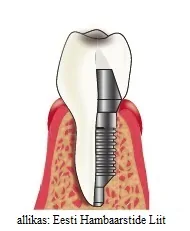Dental implants or artificial roots are used for replacing single teeth and supporting longer bridges, and microimplants are used for fixing dentures under partial dentures. An implant physiologically restores a missing tooth without gripping neighbouring teeth.
Implantology
 What should be taken into Account in case of dental implants?
What should be taken into Account in case of dental implants?
- If there is not enough bone, a procedure to grow bone has to be done beforehand.
- If the row of teeth has shifted due to a missing tooth, orthodontic treatment may be required beforehand.
- Because installing implants means attaching an artificial root in the jawbone, the risks accompanying it are similar to any artificial material installed in the body. Experiences show that less than 10% of patients develop complications. In rare cases, there may be a “rejection reaction”.
- After installation, the patient has to take painkillers on the first day and antibiotics for five days.
- Initial healing takes two weeks, but the superstructure can be only installed in six months to one year, or when the implant has fixed itself in the bone.
- In case of larger defects, temporary dentures are likely required in the meantime.
How Is The Implant Installed?
1. Appointment
- Consultation.
- X-ray.
- Measuring bone parameters In case of major works and several implants, imprints are taken and a wax reconstruction is ordered from the laboratory. Once the installation date has been agreed on, the patient begins an antibiotics treatment the day before.
2. Appointment
Implants are installed under local anaesthesia. It is first made sure that the patient has developed full anaesthesia, and then the implant is installed. Installing one implant takes about 25-35 minutes. Two stitches are made.
3. Appointment
- Inspecting the wound and removing stitches.
- X-ray.
4. Appointment
In six months, installation of the superstructure begins (see prosthetics, implant crown).

Complications or what could happen during installation?
- Risk of hitting the nerve canal in the lower jaw.
- Buccal cavities are at risk in the upper jaw.
To avoid: Parameters can be measured very accurately using an X-ray image. The implant is always made a little shorter to avoid risk.
When Should Implant Crowns Be Installed?
It is recommended to install implant crowns in six months to one year following the installation of implants. The exact installation time can be adjusted to make sure that the patient is ready for the procedure.
During The 1st Appointment
- The material and colour of the new tooth is determined.
- Healing screws fabricating the gum are reinstalled.
- Imprints are made of both jawbones, biting is determined.
- Imprinting elements are fixed.
- Healing screws are removed; the shape of the gum is adjusted with a laser if necessary.
During The 2nd Appointment
- The connecting element or abutment is checked.
- In case of a smaller unit, the crown can be made and cemented in the mouth immediately.
- Abutment or connecting element is fixed separately and tightened with an instrument corresponding to the system.
- A crown is then cemented on the abutment. If necessary, one more appointment is made.
What Should Be Taken Into Account With Respect To Implant Crowns?
Because installing implants means attaching an artificial root in the jawbone, the risks accompanying it are similar to any artificial material installed in the body. Experiences show that less than 10% of patients develop complications.
Building a crown on the implant is practically safe.
Subsequent hygiene and regular check-ups once a year, also contacting the doctor who installed the implant in case of the smallest of issues is important.
It is easy to restore each tooth on the row of teeth separately and ensure the maximum physiological functioning of the entire row of teeth.
Do Implant Crowns Require Special Care?
Similar to a regular crown, the implant crown requires careful cleaning to prevent bacteria from collecting under the edges of the crown and causing peri-implantitis or inflammation of the tissues surrounding the implant.
Treatment: Proper crown edges and smooth transitions from crown to connecting element or abutment are easy to clean. Today’s accurate methods mean that pathological collection of food and bacteria is rare. In daily care of teeth with crowns, we recommend that the regular brushing of teeth is supplemented with using dental floss, mouth wash and air-floss device from Philips. Once a year, the oral cavity should be professionally cleaned using the air-flow procedure.
In the event of even the smallest of issues with implants, turn to the doctor who installed the implants as soon as possible.
Please find the prices for implantology HERE
